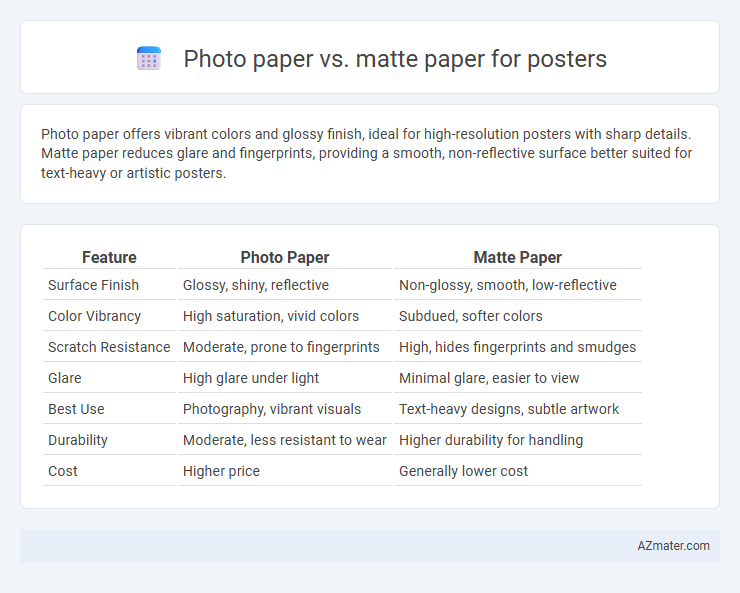Photo paper offers vibrant colors and glossy finish, ideal for high-resolution posters with sharp details. Matte paper reduces glare and fingerprints, providing a smooth, non-reflective surface better suited for text-heavy or artistic posters.
Table of Comparison
| Feature | Photo Paper | Matte Paper |
|---|---|---|
| Surface Finish | Glossy, shiny, reflective | Non-glossy, smooth, low-reflective |
| Color Vibrancy | High saturation, vivid colors | Subdued, softer colors |
| Scratch Resistance | Moderate, prone to fingerprints | High, hides fingerprints and smudges |
| Glare | High glare under light | Minimal glare, easier to view |
| Best Use | Photography, vibrant visuals | Text-heavy designs, subtle artwork |
| Durability | Moderate, less resistant to wear | Higher durability for handling |
| Cost | Higher price | Generally lower cost |
Introduction to Photo Paper and Matte Paper
Photo paper features a glossy or semi-glossy finish that enhances color vibrancy and sharpness, making it ideal for high-resolution images and photographic posters. Matte paper, with its non-reflective surface, reduces glare and fingerprints, offering a smooth texture that suits art prints and designs requiring subtle tones. Choosing between photo paper and matte paper depends on the desired visual impact and display environment of the poster.
Key Differences Between Photo and Matte Paper
Photo paper delivers vibrant colors and sharp details with a glossy or semi-gloss finish, making it ideal for high-resolution images and posters requiring vivid visual impact. Matte paper offers a non-reflective surface that reduces glare and fingerprints, providing a smooth, textured appearance suitable for posters emphasizing text clarity and subtle tones. The choice between photo and matte paper impacts color saturation, finish durability, and viewing angle sensitivity, crucial factors for poster presentation.
Print Quality: Glossy vs. Matte Finish
Photo paper offers vibrant color reproduction and sharp detail due to its glossy finish, enhancing the visual impact and making images pop with a reflective shine. Matte paper, with its non-reflective surface, reduces glare and fingerprints, delivering a smooth, muted look that highlights textures and subtle color variations without sacrificing detail. Choosing between photo paper and matte paper depends on whether the desired print quality emphasizes vivid brightness and contrast or soft, natural tones with minimal shine.
Color Vibrancy and Image Sharpness
Photo paper delivers superior color vibrancy and image sharpness, making it ideal for posters requiring bright, vivid visuals. Matte paper reduces glare and offers a softer finish, but this can slightly dull colors and decrease sharpness compared to photo paper. For posters emphasizing bold colors and crisp detail, photo paper typically provides a more impactful result.
Durability and Longevity of Prints
Photo paper offers superior durability and color longevity due to its glossy, coated surface that resists moisture and fading, making it ideal for vibrant, long-lasting posters. Matte paper, while less resistant to fingerprints and moisture, reduces glare and maintains print clarity over time but may show signs of wear more quickly. For posters requiring extended durability and vivid detail retention, photo paper is typically the preferred choice.
Best Use Cases for Photo Paper Posters
Photo paper posters offer vibrant color reproduction and high-gloss finishes, making them ideal for photographic prints, promotional materials, and vibrant art displays. These papers enhance fine details and sharpness, perfect for marketing campaigns, event posters, and high-impact visuals requiring eye-catching appeal. Matte paper suits subtle designs, but photo paper excels in presenting photos with dynamic contrast and vivid hues.
Ideal Applications for Matte Paper Posters
Matte paper is ideal for posters displayed in well-lit environments where glare reduction is crucial, such as art galleries, exhibitions, and office spaces. Its non-reflective surface enhances readability and allows vibrant colors to appear more natural and subdued, making it suitable for detailed graphics and textual information. Matte paper also resists fingerprints and smudges, providing a clean, professional look for long-term displays.
Cost Comparison: Photo Paper vs Matte Paper
Photo paper typically costs more than matte paper due to its glossy finish and higher quality ink absorption, making it ideal for vibrant poster prints. Matte paper offers a budget-friendly alternative with a non-reflective surface that reduces glare, suitable for large-format posters requiring economical production. Choosing between photo paper and matte paper depends on balancing print quality preferences against overall project costs.
Environmental Impact and Sustainability
Photo paper often contains glossy coatings made from plastic and chemical additives, which can hinder biodegradability and complicate recycling processes. Matte paper generally uses fewer chemical treatments and biodegradable fibers, making it a greener choice with reduced environmental footprint. Choosing matte paper for posters supports sustainability by minimizing waste and promoting easier recycling in paper waste management systems.
Choosing the Right Paper for Your Poster
Choosing the right paper for your poster depends on the desired finish and durability; photo paper offers vibrant colors and glossy shine ideal for high-resolution images, while matte paper provides a non-reflective surface that reduces glare and fingerprints. Photo paper is best suited for professional displays needing vivid detail, whereas matte paper works well for posters intended for reading and frequent handling. Consider the environment and viewing distance to ensure your poster communicates effectively and maintains its quality over time.

Infographic: Photo paper vs Matte paper for Poster
 azmater.com
azmater.com